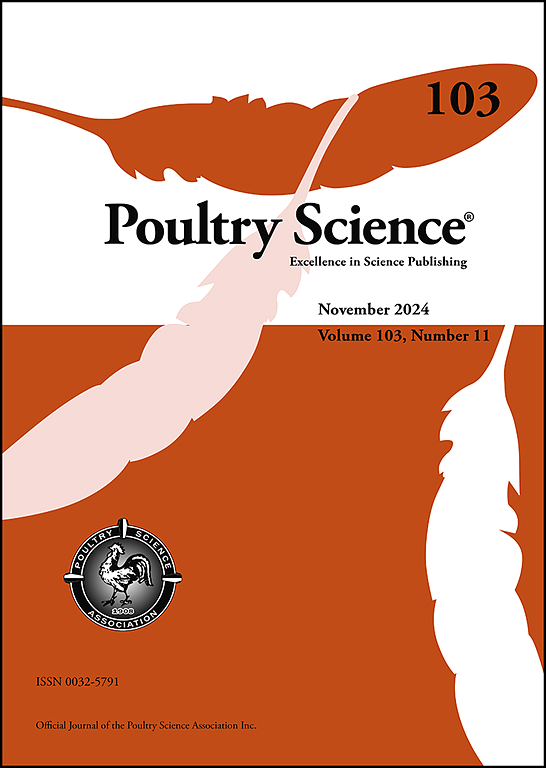Research note: The effect of passionflower supplementation on feather pecking in laying hens
IF 3.8
1区 农林科学
Q1 AGRICULTURE, DAIRY & ANIMAL SCIENCE
引用次数: 0
Abstract
Feather pecking is a significant issue in non-caged poultry welfare that results in the removal or damage of the feather of a hen. The most common forms are classified into gentle feather pecking and severe feather pecking which, if undeterred, can develop into cannibalism. This case study explored one aspect of the prevention of feather pecking, investigating if the feed additive Gallicalm, containing Passionflower, reduced feather pecking behavior in a free-range flock.
Video footage over 6 weeks was analysed for feather pecking incidence in 2-week phases; Pre-Treatment, Treatment and Post-Treatment. Standard commercial rations were fed in the Pre-Treatment and Post-Treatment phases, with the Treatment phase receiving the standard commercial ration plus 1 kg per ton of Gallicalm. Feather scores were completed using the AssureWel method at the end of each phase, with production data collected through an online flock management tool. A total of 373 minutes of footage from 18 days was analysed for pecking behavior.
Supplementation resulted in reduced number of severe feather pecks in the Pre-Treatment phase to the Treatment phase. Gentle pecking failed to decrease significantly during Gallicalm Treatment but increased in the post-Treatment phase. Aggressive, stereotypical and beak pecking were rare in all experimental phases. Feather scores deteriorated between the Pre-Treatment and Treatment phase but plateaued between the Treatment and Post-Treatment phase.
This case study provides the first evidence of passionflower-containing supplements reducing feather pecking in laying hens. Given the billions of laying hens kept globally and the extensive welfare and economic issues associated with feather pecking, we advocate for further study to build on our initial findings.
研究说明:补充西番莲对蛋鸡啄羽的影响
本文章由计算机程序翻译,如有差异,请以英文原文为准。
求助全文
约1分钟内获得全文
求助全文
来源期刊

Poultry Science
农林科学-奶制品与动物科学
CiteScore
7.60
自引率
15.90%
发文量
0
审稿时长
94 days
期刊介绍:
First self-published in 1921, Poultry Science is an internationally renowned monthly journal, known as the authoritative source for a broad range of poultry information and high-caliber research. The journal plays a pivotal role in the dissemination of preeminent poultry-related knowledge across all disciplines. As of January 2020, Poultry Science will become an Open Access journal with no subscription charges, meaning authors who publish here can make their research immediately, permanently, and freely accessible worldwide while retaining copyright to their work. Papers submitted for publication after October 1, 2019 will be published as Open Access papers.
An international journal, Poultry Science publishes original papers, research notes, symposium papers, and reviews of basic science as applied to poultry. This authoritative source of poultry information is consistently ranked by ISI Impact Factor as one of the top 10 agriculture, dairy and animal science journals to deliver high-caliber research. Currently it is the highest-ranked (by Impact Factor and Eigenfactor) journal dedicated to publishing poultry research. Subject areas include breeding, genetics, education, production, management, environment, health, behavior, welfare, immunology, molecular biology, metabolism, nutrition, physiology, reproduction, processing, and products.
 求助内容:
求助内容: 应助结果提醒方式:
应助结果提醒方式:


